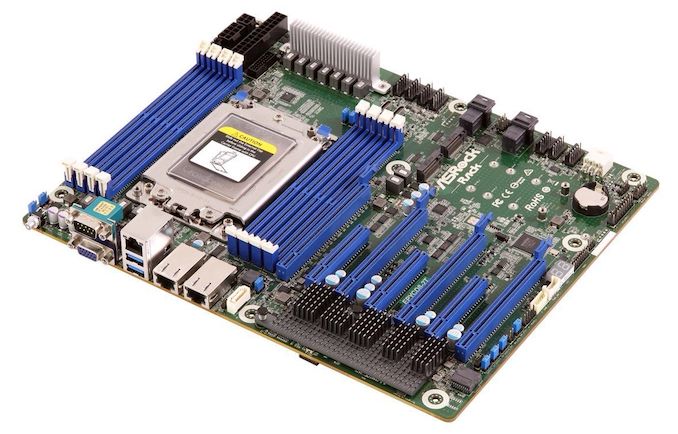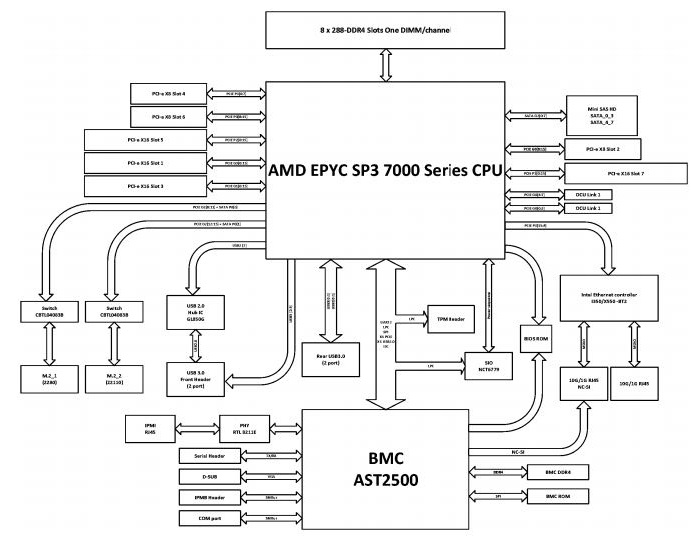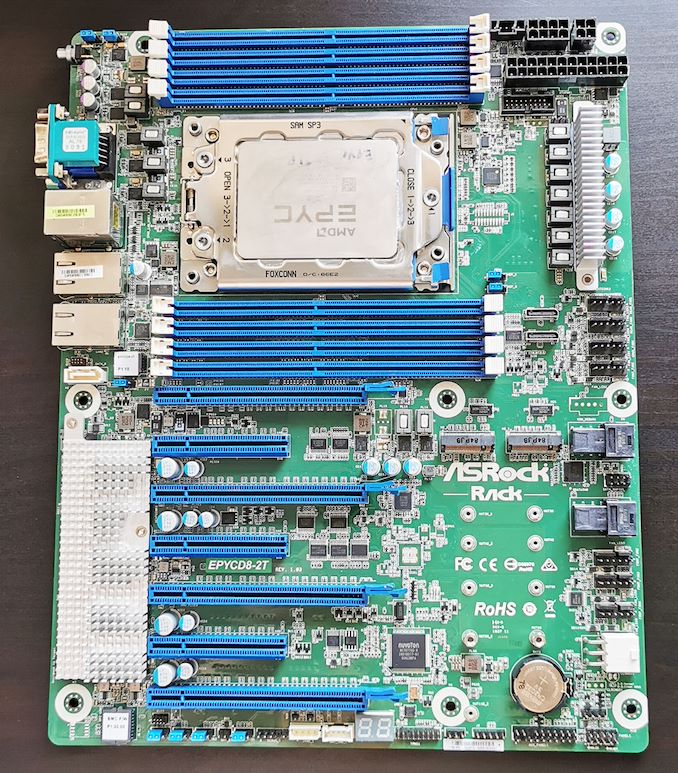The ASRock Rack EPYCD8-2T Motherboard Review: From Naples to Rome
by Gavin Bonshor on April 20, 2020 9:00 AM EST- Posted in
- Motherboards
- AMD
- Workstation
- server
- ASRock Rack
- Naples
- Rome
- EPYC 7351P
- EPYCD8-2T

It's no secret that AMD is looking to carve out a bigger share in the server market with their enterprise EPYC processors, and much fanfare has been made about the high core-count offered for the price when compared to Intel's Xeon range of processors. The ASRock Rack EPYCD8-2T looks to utilize all of the processing power offered by AMD's EYPC, and the EPYCD8-2T has a professional-centric feature set built into its ATX design. We also have eight memory slots, up to nine SATA ports, has two OCuLink to U.2 slots, dual 10 G Ethernet, and seven PCIe 3.0 slots. This model also supports both AMD's EPYC 7001 Naples and 7002 Rome processors (Rome via an update).
ASRock Rack EPYCD8-2T Overview
ASRock Rack is the enterprise arm of ASRock, and caters to the workstation, server and data center market. For the longest time, ASRock Rack catered mainly to Intel's offerings, including Intel Xeon and the large Atom designs. Now the company has a small but expanding team focusing on the EPYC side of the market, and the ASRock Rack EPYCD8-2T is an ATX sized solution which is compatible with both Naples and Rome. Today we will be focusing on the EPYCD8-2T and its server and workstation feature set.
The ASRock Rack EPYCD8-2T is an ATX sized single LGA 4094 socket option designed for AMD's EPYC processors. The board has an all-green PCB and has a transposed CPU socket designed for more efficient airflow when installed into a 1U or related chassis type. Memory support stretches across eight slots with support for RDIMMS up to 32 GB, and LRDIMMs up to 128 GB per slot. This means that the EPYCD8-2T can house up to 1 TB of DDR4 operating in eight-channel. This model has supports DDR4-3200/2933/2666/2400, both in the RDIMM and LRDIMM variety.
Providing BMC maintenance functions is the stalwart Aspeed AST2500 management controller which allows users to remotely manage the system. The networking is taken care of by an Intel X550-AT2 Ethernet controller which provides dual 10 G Ethernet on the rear panel. A separate Realtek RTL8211E acting as a dedicated IPMI Ethernet port, with a D-sub 2D video output powered by the Aspeed AST2500.
On the PCIe front, the ASRock Rack EPYCD8-2T has plenty of expansion slot support to make the most of the 128 lanes from the CPU. which include four full-length and three half-length (but open-ended) PCIe 3.0 slots. These slots operate at x16/x8/x16/x8/x16/x8 which makes for a total of 88 PCIe 3.0 lanes dedicated to graphics and expansion support.
For the storage, ASRock Rack includes two mini SAS HD connectors which each offers the capability to install up to four SATA devices, with up to eight in total. A separate SATA DOM port allows for another SATA device to be installed bringing the boards total of SATA capability up to nine. A total of two PCIe 3.0 x4 M.2 slots are located vertically below the right-hand side bank of memory slots, with two OCuLink ports just to the right of the DRAM slots for U.2 devices.

ASRock Rack EPYCD8-2T Block Diagram
The ASRock EPYCD8-2T was originally built for Naples (7001), but Rome (7002) is supported by updating the firmware to v2.30. It is worth noting that this update requires a 32 MB BIOS chip - some of the early units (like ours) only have a 16 MB chip.
The performance of the ASRock Rack EPYCD8-2T is competitive with other models we have tested, including the GIGABYTE MZ31-AR0. In comparison to the GIGABYTE model, the EPYCD8-2T shows much better power efficiency with a strong showing in our long idle power testing, as well as at full-load with our AMD EPYC 7351P processor. Server and workstation motherboards tend to take longer to boot up into Windows due to controller and BMC initialization during POST, but our POST time testing shows the EPYCD8-2T to POST in just over 50 seconds, with a slightly quicker POST time of 45 seconds with non-essentially controllers disabled. The ASRock Rack EPYCD8-2T is the only model I've personally tested on any platform to be under 50 µs in our DPC Latency testing, making this a solid option for users building an audio-focused workstation.
The ASRock Rack EPYCD8-2T currently retails for $498 at Newegg and represents just handful of single-socket LGA4094 models at the sub $500 price point. Included in that list is the similar, but cheaper ASRock Rack EPYCD8 ($460) which is essentially the same board, but without dual 10 G Ethernet. Other models at a similar price point include the Supermicro MBD-H11SSL-NC ($470) with dual 1 G Ethernet and fewer SATA, as well as the ASUS KNPA-U16 ($462) which has superior storage and better memory support but opts for two 1GbE too. The distinguishing factor in specifications for the EPYCD8-2T that we're reviewing today is the Intel X550 Dual 10 gigabit Ethernet controller, and seven PCIe 3.0 slots which is impressive on an ATX sized model.
Read on for more extended analysis.











34 Comments
View All Comments
Hul8 - Monday, April 20, 2020 - link
Only a subset of reviewers found that that was the case. Some had the exact same results as long as they were running at least Windows 10 Pro.It may have more to do with running a later major version (like 1903 or 1909) than Pro versus Enterprise.
Hul8 - Monday, April 20, 2020 - link
Also, AMD explicitly stated that Pro and Enterprise are equivalent for performance, and they should know.Hul8 - Monday, April 20, 2020 - link
I think you're missing "/x16" at the end of "x16/x8/x16/x8/x16/x8". This listed litany only has 6 slots for a total of 72 lanes.MenhirMike - Monday, April 20, 2020 - link
Checking if this board supports bifurcation? The screenshot in https://www.anandtech.com/Gallery/Album/7564#7 shows a setting for the Link Width, but doesn't show the options. And even ASRock's manual only says "This allows you to select PCIE1 Link Width. The default value is [x16]"eastcoast_pete - Monday, April 20, 2020 - link
Maybe I overlooked it, but isn't this board intended for servers? If so, why not show some server-centric benchmarks? Wouldn't that be closer to the intended use case? I know that many "server" MBs are also used for workstations, but something intended for racks is less likely to end up in a workstation.AndrewJacksonZA - Monday, April 20, 2020 - link
That's quite the bent pin in Front Fan 4. What happened?dwade123 - Tuesday, April 21, 2020 - link
Junkarneberg - Wednesday, April 22, 2020 - link
This card have most of the things i need for my home studio (music produktion)But is it possible to install Thunderbolt in some way?
(thunderbolt and usb are the standards in the music industry at least the studio sound cards)
enzobozo - Thursday, May 7, 2020 - link
https://www.asrockrack.com/general/productdetail.a...thunderbolt is ready to plug in that one.
https://www.youtube.com/watch?v=Q95RlXh9BPA
https://download.asrock.com/Manual/QIG/ROMED8-2T.p...
https://download.asrock.com/Manual/ROMED8-2T.pdf
arneberg - Wednesday, April 22, 2020 - link
another question about the latency, is it low compaired with Intels mobo also, or is it only low compaired with other AMD cards.Is it the latency with the processor, or only the motherboard? the old rule was to use a intel motherboard for music-produktion. Was something with the AMD processors but that was then, now it ´s new times,